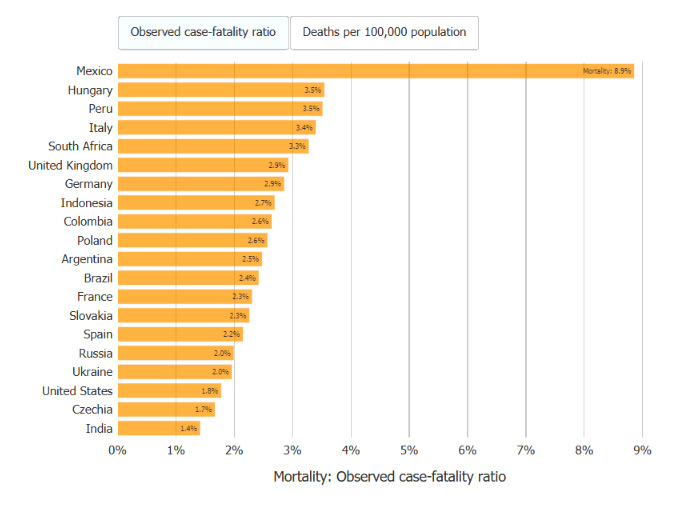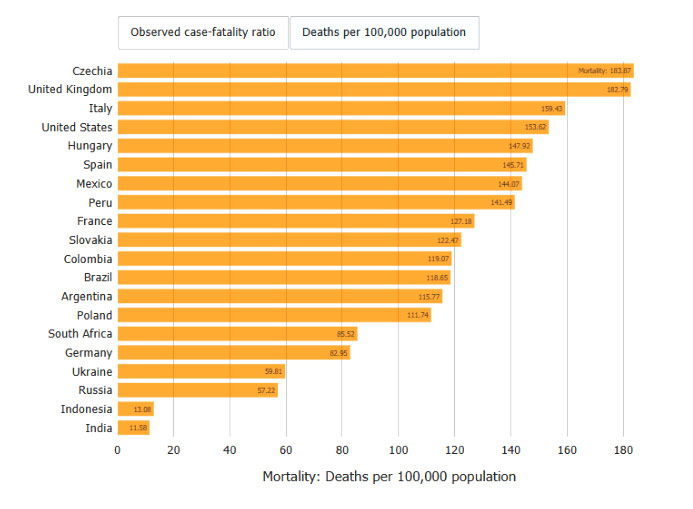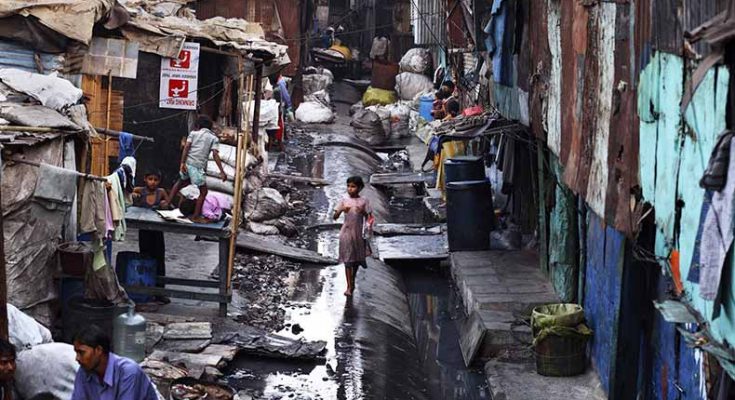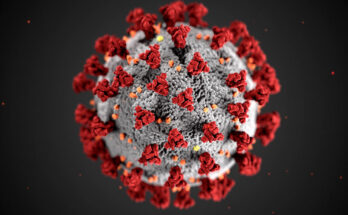Why India’s mortality rate due to COVID-19 pandemic is so low? Image Courtesy – Pinterest
The corona pandemic hit the world very hard along with India. Over 11 million cases have been reported and more than 150 thousand people died in this country. Even the mortality rate due to COVID-19 has been lower compared to other countries of the world. The reason is beyond explanation.
The US leads the world with more than 20 million cases and over 500 thousand deaths. According to the Johns Hopkins University & Medicine, Coronavirus Resource Center, the observed case-fatality ratio is very low (1.4%) among the 20 countries. According to their report, the number of deaths per 1,00,000 population is only 11.58 (lowest) among the 20 countries.
The mortality is shown in the most affected countries:


In the above pictures, the graphs of Mortality analysis are shown according to the Johns Hopkins University & Medicine. Image Courtesy – Johns Hopkins University & Medicine
Why coronavirus has become less devastating in India so far?
Before the arrival of the 2nd wave of COVID-19 in India, let us try to analyze the reasons. The assessment of Epidemiologists and scientists went wrong so far as India experienced a low mortality rate from the Novel Coronavirus despite the crowded conditions in urban life.
Let me try to explain some of the points that might affect the mortality rate in India.
Read: BCG vaccine may be an alternative to fight against coronavirus
Effect of BCG Vaccine:
(BCG) vaccine (full name – Bacillus Calmette-Guerin) is generally used for those countries where Tuberculosis and Leprosy occur frequently. BCG vaccine was being introduced in the year 1920. At that time, India was the country that had the highest number of Tuberculosis patients in the world. So, a mass immunization was ordered in 1948 in India.
A section of scientists has observed a lower death rate in people in some countries who have been vaccinated with BCG at a certain time in their lives. They compared BCG vaccination policies of the different countries and their respective death rates.
There might be a positive correlation between the two things – vaccination policy with BCG vaccine adopted by India and more protection was being provided to the people. The death rate of the nations covered with a BCG vaccination programme was 4.28/million whereas the rate in those countries without BCG vaccination programme was 40/million. So, one of the many reasons maybe is that the BCG vaccine became helpful to protect the body of many Indians from acute respiratory infections caused by the COVID-19 virus. India’s mortality rate might be reflected by one of these reasons.
Under-reporting of Covid-19 cases and deaths:
Several epidemiologists have the opinion that India’s low mortality rate has been reflected due to under-reporting. At the same time, the number of cases was also low due to under-reporting. It is a logical point on behalf of the scientists that initially the state governments of various states in India could not maintain the report of COVID-19 cases properly. Many cases remained unreported.
Another situation was being observed in the semi-urban and village areas of the country. The people with very lower-income levels just avoided the system of informing the government health department due to fear of expenses. The cost of the COVID-19 test was not within the reach of poor people. Though some of the state governments in India made the COVID-19 test free from government health centers, several other states did not give that option to the poorer section of people. That might be the cause to avoid reporting after being infected.
People were chosen not to inform the health center for another reason too. A lot of people could not arrange the charges the Municipality health department would take for sanitizing the house of the infected people during the ‘Lock Down’ period. The private nursing homes and hospitals exploited the victims and their families extremely due to this pandemic situation. They just looted the people. This is the reason why people avoided informing health care professionals.
Read: Dengue may provide immunity against Covid-19
Unhealthy, unhygienic living condition:
Apart from the posh urban areas, most of the slum areas in metro cities in India are having less space between each house. Very few houses are structured with standard norms (10 ft X 10 ft). In slum areas, 10 to 12 people dwell in each house. Social distancing is impossible in this dwelling condition along with limited options for toilets, hand washing facilities, and basic hygiene.
Even in the semi-urban areas in India, people are unable to maintain basic hygiene essentials due to very low-income levels. Maintaining basic hygienic norms is nearly a luxury to them. They use to face several infections from their childhood throughout their lives. Their bodies start to fight with so many waterborne, food-borne, and airborne diseases from childhood that their body’s immune system becomes higher than any other people in the world.
It has been observed in the past that food hygiene is very much absent in some of the cities in India. You couldn’t even trust a restaurant while you are dining out there. Some meat suppliers used to supply rotten-meats to some restaurants years after years and so many people consumed cooked food there (a non-veg item made with rotten-meat). A lot of people swallowed deadly pathogens in this way.
Immunity built from Dengue outbreaks:
In a tropical country like India, outbreaks of Dengue and Malaria are not uncommon. Outbreaks of Dengue happened several times before the pandemic of COVID-19 started to cover India.
It was found that antibodies of COVID-19 were found in the bodies of people who were affected by Dengue earlier. The antibodies found even though the people did not even have a COVID-19 infection.
At those places, where the Dengue outbreaks occurred at a huge level, the COVID-19 infection rate was lower. Scientific research revealed that an immunological cross-reactivity has taken place between Flavivirus (Dengue virus) and SARS-CoV-2 virus.
Use of herbal extracts:
The traditional system of treatment had been practiced in India since 6000 BC. It was found in the Charaka Samhita’ and Susruta Samhita’ – a collection of texts in Sanskrit. The scripts provided hygiene, diet, prevention, medical education, the teamwork of doctors and nurses which had been important for the recovery of the patients. The usage of many herbal extracts is mentioned there as ‘Rasayana’.
India has a strong history of using traditional medicine, at least for a period of 2000 years. So, it is quite normal that people in India would have searched and applied for some herbal medicines or herbal extracts during this COVID-19 pandemic also.
Yoga Guru Ramdev, the most popular yoga teacher in India has also provided his valuable suggestions in this pandemic situation for boosting immunity. He also provided herbal medicines through ‘Patanjali Ayurved’ that so many people have already used. Currently, many people are using his immunity-boosting herbal medicine against COVID-19. Those who could not collect Patanjali’s ayurvedic medicine used herbal extracts as per his suggestion, and also benefited during the COVID-19 pandemic.
The Scientists of the Indian Institute of Science Education and Research, Kalyani has also emphasized the effectiveness of Neem bark extract (Azadirachta Indica) a couple of months ago. They found that Neem bark extract minimizes the development of Cytokinin against COVID-19 infection. They also stated in their research paper that Neem bark extract can block the spike protein and replication of coronavirus.
Many people in India also used combinations of Neem, Turmeric, Basil, Giloy, and Ashwagandha in this COVID-19 pandemic. This concept was also supported by the scientists of King George’s Medical University (KGMU) in Lucknow. The scientists submitted their research paper a couple of months ago. They claimed that these herbal ingredients not only boost immunity but at the same time they prevent COVID-19 from entering the human body and spreading infection. India’s mortality rate might be reflected by this reason.
Read: COVID-19 medicine found in the extract of Neem Bark, scientists said
Habit of yoga as lifestyle:
The habit of yoga has now become a lifestyle in India. Several yoga gurus across India have been training the countrymen with their relentless efforts for decades. Yoga has now become a part of a lifestyle, and Indian people believe in yoga for maintaining hard immunity. Even the doctors have accepted that several activities of yoga can build a protective shield against various diseases.
The people, who regularly practice yoga, can combat any disease very easily. Be it a COVID-19 or any other pathogen, yoga-people can easily win over the disease because of their tremendous immunity. Yoga might be a reason for affecting India’s mortality rate in comparison to the other countries of the world.
Spiritual practices and healing:
Spiritual practices might have a great impact in this sub-continent. We know that India is a land of spirituality with a lot of religion and spiritual practices as per religious norms. People from various religions use spiritual practices. There may be the use of mantras and a combination of words that ultimately forms energy to transform. This logic is applied in meditation with specific chanting of mantras.
Here you can hear some words from Sadguru describing the awakening of ‘Kundalini Power’. Video Courtesy – YouTube
The mantras or combination of sounds is so powerful that they can activate your ‘Kundalini Chakra’ and provide you a tremendous shield against diseases. Once you can active your chakras, you can transmit your thoughts to anything and your thoughts get into action. Healing through spiritual power happens in the same way.





